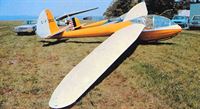
M.Simons The World's Vintage Sailplanes 1908-45
THE PRATT READ G-1, (LNE-1 OR TG-32)
The Pratt Read PR-G-1 two-seater was conceived as a US training sailplane rather than a military aircraft but the hour of its birth determined that it would be used for wartime training. It was manufactured in quantity and after successful service, the surviving aircraft were placed on the war surplus market.
The Pratt Read had the advantage of requiring no scarce light alloys. The rear fuselage was a plywood tubular structure, which attached at its front end to the steel tube framed pod or capsule. It was unique among the American military training gliders in having side-by-side seating. A large transparent canopy was fitted, with side-hinged entry hatches, and the entire canopy could be jettisoned in emergency. The rudder pedals were independently adjustable.
The tail unit was wooden-framed with plywood covering on the fin and tailplane and fabric-covered control surfaces. The rudder was mass-balanced. The landing wheel was fitted close to the centre of gravity of the aircraft when loaded, with a sprung skid under the belly ahead of the wheel. A wheel brake was interconnected with the airbrakes.
The wing planform was reminiscent of the Grunau Baby, but was larger in area and cantilevered. Near the wingtip the aerofoil was reflexed to improve aileron control. A single mainspar with plywood ‘D' nose, and a light auxiliary spar for the ailerons, followed common practice.
The prototype flew late in 1941 and a thorough test programme was carried out, proving that the G-1 was entirely suitable for training. It proved to have a quite respectable glide ratio of 1 : 23 and a minimum sinking speed under 1 metre per second. It was adopted by the Navy as the LNE-1, and on the Army list was called the TG-32. In production, the various strengthening modifications required for the fairly rough usage given by trainee military glider pilots, led to an increased structural weight and a lower cockpit load in spite of a greater permitted flying weight.
After the war, the Pratt Read became a popular civilian trainer and two were used extensively in research flights in the Californian Sierra lee waves. The Pratt Reads in this work were painted with orange fluorescent paint and, to aid radar detection, metallic foil strips were stuck on in carefully thought-out patterns. The project resulted, among other things, in several record-breaking flights. One of these still stood in 1980. This was the 13,849 metre absolute altitude flight made by Larry Edgar,and Howard Klieforth on 19th March 1952. One of these aircraft was destroyed in spectacular fashion when Edgar, in April 1955, flew inadvertently into the rotor of the wave at about 4,500 metres. He was thrown out of control by the turbulence, the glider broke up around him and he suddenly found himself falling with only the remnants of rudder pedals attached to his feet. His parachute saved him, but the severe negative ‘g’ loads to which he had been subjected, damaged his eyes.
Of the 75 Pratt Reads built, about a third were still registered in the USA in 1974. Probably not all these were still in regular use.
Technical data:
Pratt Read G-1. Prototype: Span, 16.66m. Wing area, 21.37 sqm. Aspect ratio, 12.91. Empty weight, 265 kg. Flying weight, 453.5 kg. Wing loading, 24.4 kg/sq m. Best glide claimed, 1 : 23. Aerofoils; root, GS-4; mid-span, GS-M and tip, GS-1.
LNE-1: As for prototype but empty weight, 349 kg. Flying weight 521.5 kg. Wing loading, 24.4 kg/sq m.
- M.Simons The World's Vintage Sailplanes 1908-45
Фотографии
-
GL / M.Simons - The World's Vintage Sailplanes 1908-45 /Kookaburra/
Регистрационный номер: C-FZCC A restored Pratt Read G-I or LNE-1, carrying a Canadian registration. The TG-2 and Kirby Gull 1 are visible in the background.
Другие самолёты на фотографии: Schweizer SGS 2-8 / TG-2 - США - 1938Slingsby T.12 / T.14 / T.15 Gull - Великобритания - 1938
-
Air Enthusiast 2007-05 / B.Norton - Ready for the Silent Assault /World war two/ (2)
The two-place Pratt, Read & Co LNE-1 was built for Navy and Marine Corps glider pilot training and featured unusual side-by-side seating. That programme folded in 1943 and the gliders were transferred to the Army as the TG-32, though they were simply stored.
-
GL / M.Simons - The World's Vintage Sailplanes 1908-45 /Kookaburra/
Регистрационный номер: N63192 A Pratt Read G1 flying in California.
-
GL / M.Simons - The World's Vintage Sailplanes 1908-45 /Kookaburra/
An unusual head-on view of the Canadian example.
-
GL / M.Simons - The World's Vintage Sailplanes 1908-45 /Kookaburra/
Pratt Read G-1 (LNE-1)
- Фотографии




